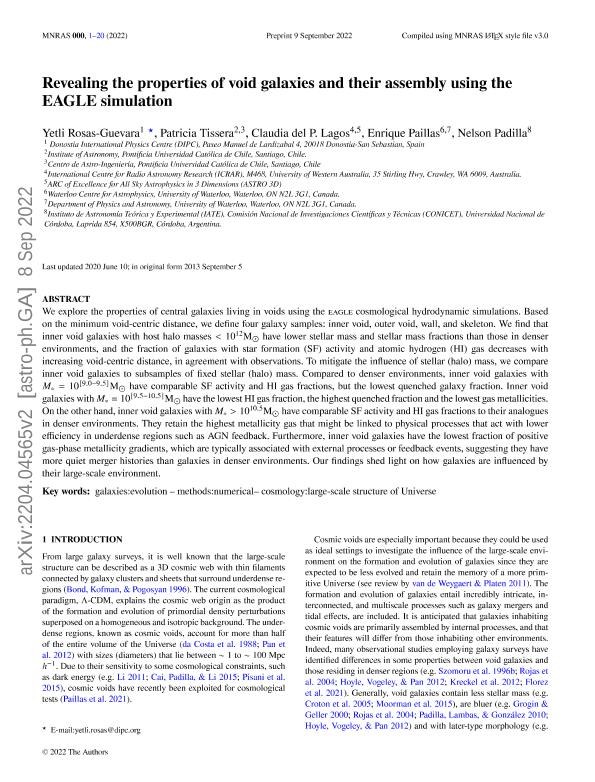Artículo
Revealing the properties of void galaxies and their assembly using the eagle simulation
Rosas Guevara, Yetli; Tissera, Patricia Beatriz ; Lagos, Claudia del P; Paillas, Enrique; Padilla, Nelson David
; Lagos, Claudia del P; Paillas, Enrique; Padilla, Nelson David
 ; Lagos, Claudia del P; Paillas, Enrique; Padilla, Nelson David
; Lagos, Claudia del P; Paillas, Enrique; Padilla, Nelson David
Fecha de publicación:
11/2022
Editorial:
Oxford University Press
Revista:
Monthly Notices of the Royal Astronomical Society
ISSN:
0035-8711
Idioma:
Inglés
Tipo de recurso:
Artículo publicado
Clasificación temática:
Resumen
We explore the properties of central galaxies living in voids using the EAGLE cosmological hydrodynamic simulations. Based on the minimum void-centric distance, we define four galaxy samples: inner void, outer void, wall, and skeleton. We find that inner void galaxies with host halo masses <1012M⊙<1012M⊙ have lower stellar mass and stellar mass fractions than those in denser environments, and the fraction of galaxies with star formation (SF) activity and atomic hydrogen (H I) gas decreases with increasing void-centric distance, in agreement with observations. To mitigate the influence of stellar (halo) mass, we compare inner void galaxies to subsamples of fixed stellar (halo) mass. Compared to denser environments, inner void galaxies with M∗=10[9.0−9.5]M⊙M∗=10[9.0−9.5]M⊙ have comparable SF activity and H I gas fractions, but the lowest quenched galaxy fraction. Inner void galaxies with M∗=10[9.5−10.5]M⊙M∗=10[9.5−10.5]M⊙ have the lowest H I gas fraction, the highest quenched fraction and the lowest gas metallicities. On the other hand, inner void galaxies with M∗>1010.5M⊙M∗>1010.5M⊙ have comparable SF activity and H I gas fractions to their analogues in denser environments. They retain the highest metallicity gas that might be linked to physical processes that act with lower efficiency in underdense regions such as AGN (active galaxy nucleus) feedback. Furthermore, inner void galaxies have the lowest fraction of positive gas-phase metallicity gradients, which are typically associated with external processes or feedback events, suggesting they have more quiet merger histories than galaxies in denser environments. Our findings shed light on how galaxies are influenced by their large-scale environment.
Palabras clave:
Galaxies
,
Simulations
Archivos asociados
Licencia
Identificadores
Colecciones
Articulos(IATE)
Articulos de INST.DE ASTRONOMIA TEORICA Y EXPERIMENTAL
Articulos de INST.DE ASTRONOMIA TEORICA Y EXPERIMENTAL
Citación
Rosas Guevara, Yetli; Tissera, Patricia Beatriz; Lagos, Claudia del P; Paillas, Enrique; Padilla, Nelson David; Revealing the properties of void galaxies and their assembly using the eagle simulation; Oxford University Press; Monthly Notices of the Royal Astronomical Society; 517; 1; 11-2022; 712-731
Compartir
Altmétricas



